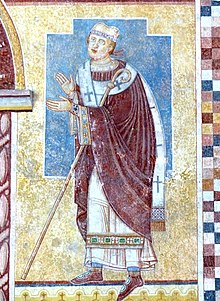Otto of Bamberg
This article needs additional citations for verification. (March 2013) |
Saint Otto of Bamberg | |
|---|---|
 | |
| Bishop and Confessor; Apostle of Pomerania | |
| Born | c. 1060 Mistelbach, Franconia(?) |
| Died | 30 June 1139 Bamberg, Franconia |
| Venerated in | Catholic Church |
| Canonized | 1189, Rome by Pope Clement III |
| Major shrine | Michaelsberg Abbey, Bamberg, Bavaria, Germany |
| Feast | 2 July |
Otto of Bamberg (Template:Lang-de, Template:Lang-pl; 1060 or 1061 – 30 June 1139) was Bishop of Bamberg and a missionary who, as papal legate, converted much of medieval Pomerania to Christianity.
Early life
According to scarce contemporary sources, Otto was born into a noble (edelfrei) family which held estates in the Swabian Jura. A possible descent from the Franconian noble house of Mistelbach or a maternal relation with the Hohenstaufen dynasty has not been conclusively established. As his elder brother inherited their father's property, Otto prepared for an ecclesiastical career and was sent to school,[1] probably in Hirsau Abbey or one of its filial monasteries.
When in 1082 the Salian princess Judith of Swabia, sister of Emperor Henry IV, married the Piast duke Władysław I Herman, he followed her as a chaplain to the Polish court. In 1091 he entered the service of the Henry IV; he was appointed the emperor's chancellor in 1101[2] and supervised the construction of Speyer Cathedral.
Bishop

In 1102, the emperor appointed and invested him as Bishop of Bamberg in Franconia (now in the state of Bavaria), and Otto became one of the leading princes of medieval Germany. He consolidated his widely scattered territories and during his tenure as bishop, Bamberg rose to great prominence.
In 1106 Otto received the pallium from Pope Paschal II. He achieved fame as diplomat and politician, notably during the Investiture Controversy between the emperor and the papacy. It was Bishop Otto, substituting the imprisoned archbishop Adalbert of Mainz, who clothed Hildegard of Bingen as a Benedictine nun at Disibodenberg Abbey about 1112.[3] He remained loyal to the Imperial court and, as a consequence, was suspended by a papal party led by Cuno of Praeneste at the Synod of Fritzlar in 1118. At the Congress of Würzburg in 1121, Otto successfully negotiated the peace treaty, the Concordat of Worms, which was signed in 1122.[2] In the 1130s, he continued to arbitrate between Emperor Lothair of Supplinburg and the rising Hohenstaufens.
As bishop, Otto led a model, simple and frugal life, but did much to improve his ecclesiastical and temporal realms. He restored and completed Bamberg Cathedral after it had been damaged by fire in 1081, improved the cathedral school, established numerous monasteries[2] and built a number of churches throughout his territory. He greatly expanded the town of Bamberg, rebuilding the Monastery of St. Michael, which had been destroyed by an earthquake around 1117.[4]
Missionary
Among his great accomplishments was his peaceful and successful missionary work among the Pomeranians, after several previous forcible attempts by the Polish rulers and the Spanish bishop Bernard to convert Pomerania to Christianity had failed. Otto was sent on his first mission by the Polish duke Bolesław III Wrymouth in 1124.[5] As the official papal legate, he converted a large number of Pomeranians, notably in the towns of Pyrzyce, Kamień, Szczecin, and Wolin, and established eleven churches, and became known as the "Apostle of Pomerania."
After he returned to Bamberg in 1125, some pagan customs began to reassert themselves, and Otto journeyed once more to Pomerania in 1128. In the Diet of Usedom, he succeeded in converting all the nobles, converted further communities, and sent priests from Bamberg to serve in Pomerania. His intent to consecrate a bishop for Pomerania was thwarted by the bishops of Magdeburg and Gniezno who claimed metropolitan rights over Pomerania. Only after his death in 1139 was his former companion, Adalbert of Pomerania, consecrated as Bishop of Wolin, in 1140.

Otto died on 30 June 1139, and was buried in Michaelsberg Abbey, Bamberg. He was canonised in 1189 by Pope Clement III. Although he died on 30 June, his name is recorded in the Roman martyrology on 2 July.
The area of western Prussia around Gdańsk was Christianized via Pomerania as well, and the monastery of Oliwa at Gdańsk was established at that time, while eastern Prussia was Christianized later via Riga by the Teutonic Knights.
See also
References
- ^ Jaeger, C. Stephen. The Origins of Courtliness: Civilizing Trends and the Formation of Courtly Ideals, 939-1210, Chap.2, University of Pennsylvania Press, 1985
- ^ a b c Löffler, Klemens. "St. Otto." The Catholic Encyclopedia. Vol. 11. New York: Robert Appleton Company, 1911. 28 Mar. 2013
- ^ Benedict XVI, General Audience, 1 September 2010, Vatican News Service
- ^ St. Michael's Monastery, Bamberg
- ^ "St. Otto, Bishop". Catholic News Agency
- Charles Henry Robinson (editor), "The Life of Otto, Apostle of Pomerania, 1060-1139", New York: The Macmillan Company, 1920. Two contemporary biographies by Ebbo, d. 1163 and Herbordus, d. 1168 - from Internet Archive.
